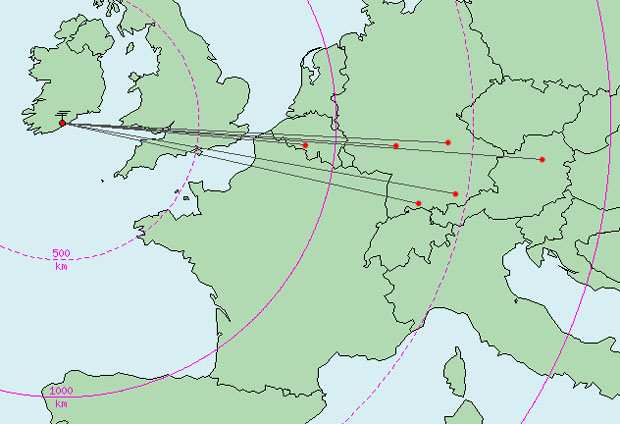Back in
early 2018, the
40 MHz (8-metre) band was allocated to radio amateurs in Ireland (EI) on a secondary non-interference basis. Now we have news that the very first beacon on
40 MHz in Ireland is operational!
The new beacon is operational since the 9th of May 2020 and has the call
EI1KNH. It is on
40.013 MHz and runs 20 watts into a vertical half-wave antenna.
The new 8-metre beacon is co-sited with some of the existing Irish beacons - EI0SIX on 50 MHz, EI1KNH on 60 MHz and EI4RF on 70 MHz. The elevated site has a locator of IO63VE and is located about 20 kms to the south of Dublin.
The photo above shows the vertical folded dipole for the 60 MHz beacon and the vertical half-wave for the 40 MHz beacon. This is a converted CB antenna which was reduced in length to a half-wave for the 8-metre band.
The 40 MHz beacon transmits on the digital PI4 mode and CW. Details below...
PI4 + CW + Carrier 00111 (1st, 2nd & 3rd Minute of every 5 minutes) Synchronised Beacon Project (SBP)
The RF for the beacon is generated by an RFZero module running about 20 milliwatts (+13dBm).
The output of the RFZero is then fed into a Chinese 'mini PA' unit. This boosts the power from 2 milliwatts to 500 milliwatts.
 |
Chinese 'mini PA'
|
 |
Inside the 'mini PA'
|
The 0.5 watt signal from the mini-PA is then fed into the main power amplifier...
The main amp is a MRF101AN which is fed from a 42 volt switch mode power supply. While the 101 NXP chip is meant to run at 50v by design, they are running it at 42v as the available PSU offers that at 50 amps. Tim comments that running it at 42v should extend its life and ensure that it can run almost undamaged into any load should the antenna break or the filter fail etc.
 |
Close up of the PA module
|
This is then fed into a homebrew band pass filter for 40 MHz...
 |
40 MHz Band Pass Filter under test
|
The 20 watt output then goes to a vertical half wave about 5 metres above ground level.
Expected Range???..... What range might be expected from a beacon on 40 MHz? Considering it a weak signal mode, a tropo range of somewhere in the range of 200 kms might be expected. Perhaps up to 300 kms during times of high pressure.
It's important to note however that the Dublin and Wicklow mountains which are just to the west will attenuate the signals in that direction. Even though the beacon site is roughly 300 metres above sea level, the mountains to the west are at least 300 meres higher.
The path across to the west coast of Wales and the UK is much better. A good guide would be the other beacons on 50 MHz and 70 MHz. If you can hear those then there is a reasonable chance of hearing the 40 MHz beacon.
Sporadic-E Range... It's certain that the 40 MHz beacon will be heard in Europe during the Sporadic-E season from late April to mid-August. The beacon has a very good view to the east with no obstructions on the horizon so it should be very strong in Europe.
The map below shows the approximate limit of one hop Sporadic-E. It's likely that stations in the Baltic states, Poland, Hungary, Austria, Italy and the south of Spain should be able to hear it on a regular basis.
When conditions are really good, stations in France, Germany, Denmark, Sweden and Norway should be able to hear it.
Shorter skip than that might be a problem though. If it's is exceptional then the skip might shorten to say the east coast of the UK.
North America???.... There is a possibility that the beacon could be heard in North America via multi-hop Sporadic-E. It just needs someone over there to make the effort. The beacon however has some 600m high mountains just to the west which may well cut off any signals in that direction.
Reports... Reception reports should be sent to Tim EI4GNB. Look up EI1KNH on
https://www.qrz.com/
Thanks to the hard work of Tim EI4GNB and Tony EI7BMB, there is now a second beacon on 40 MHz operational in Europe.
Thanks to Tim EI4GNB for all of the information and photos about the beacon.
Links...


































